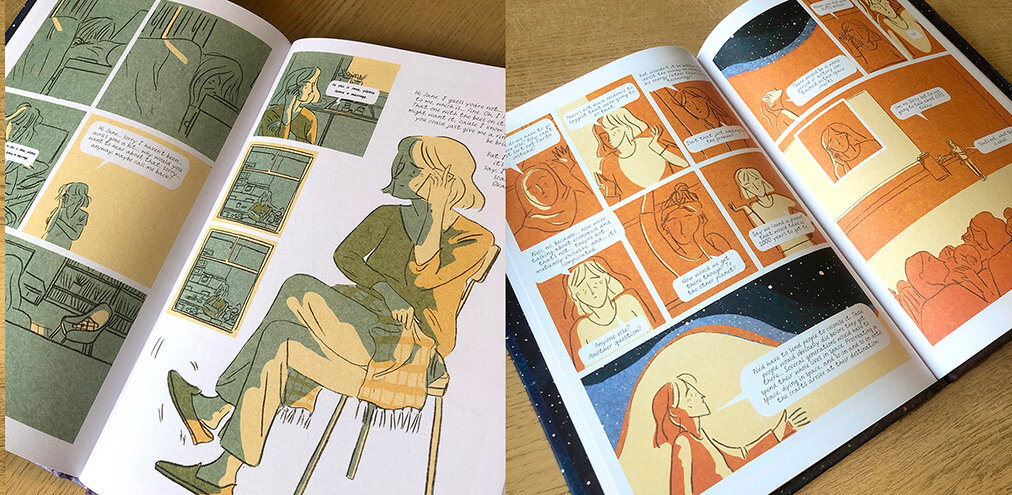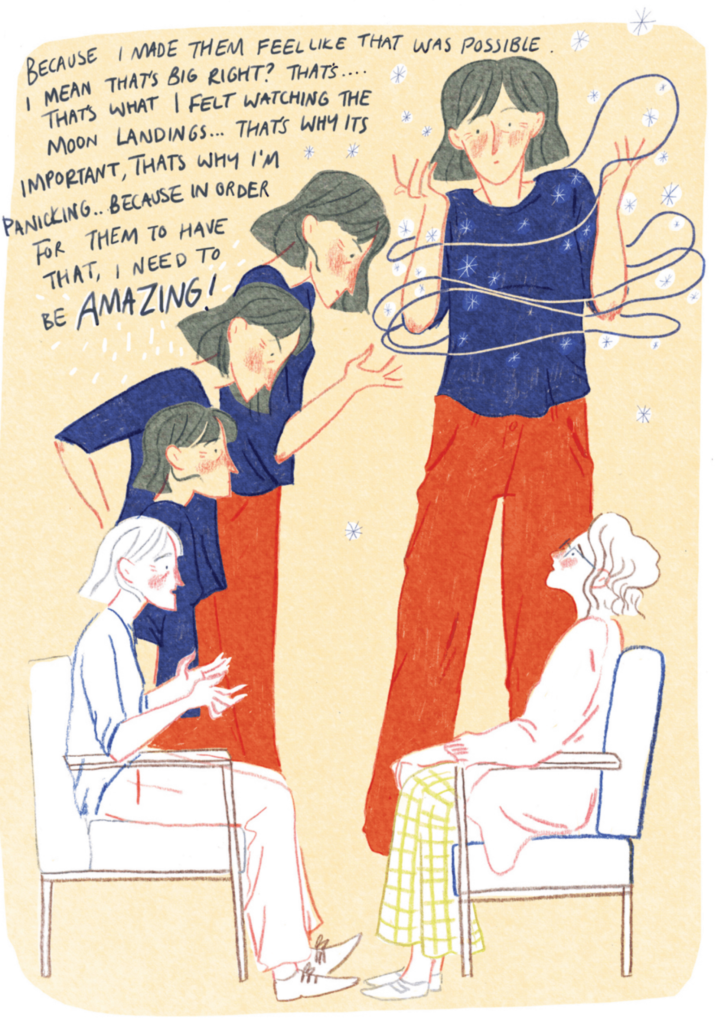Writer Molly Naylor‘s Lights, Planets, People! began as a theatrical play “about space science, mental health, and communication – both interpersonal and intergalactic.” Written by Molly Naylor, the stage show starred Karen Hill as astronomer Maggie Hill who is giving a lecture about her career to inspire young women to find their place in science. She is also attending her first therapy session to address the debilitating anxiety she has about standing up on stage to deliver this lecture. As she examines her greatest achievements and regrets, she begins to understand just how much her struggles with bipolar disorder have affected her life, especially when it comes to the woman she let walk away.
The one-woman play starred Karen Hill. With a new adaptation from Avery Hill Publishing, illustrator Lizzy Stewart now brings Maggie to life in graphic novel format. Here the creative team talks about their new book.
What was the inspiration for this story? How did you make the connection between astronomy and mental health and interpersonal relationships?
Naylor: That’s a great question and I actually don’t really know the answer to it — it was an instinctive decision that intuitively felt rich with potential for metaphor, symbolism, and parallels. Because the idea began on a residency where I met space scientists, Maggie was always an astronomer. Then, as I built her character, I made some decisions (her queerness, her age, her bipolar, her specific pre-existing emotional flaws) that led to the bigger theme around communication and how tricky it can be. I liked discovering the irony of Maggie’s meta-quest for intergalactic communication juxtaposed with her ineptitude in terms of day-to-day communication.
Was actor Karen Hill involved in any way with the graphic novel’s creation? Has she seen it since? What does she think?
Naylor: Karen was aware of it and remained very curious throughout, but wasn’t involved in the continued story development. Her job was done by that point, but she remained in my mind throughout the process. I wanted to make her proud, and to expand Maggie’s story in a way that felt real and credible to Karen. She’s read it now and approves!
Writing this story for a different medium allows for many opportunities to tweak elements of the telling to suit the new medium. What thought processes went into making these adjustments? What did you learn from the experience of retelling the story in this new way?
Naylor: Adapting from stage to page is tough because theatre relies so heavily on speech and dialogue whereas comics is obviously a very visual medium. I made this leap by basically turning the stage play into a screenplay, which meant realising whole sequences that had existed as back story/context or were reported in dialogue in the stage play. I also used a lot of what you’d call voiceover in film, but is probably called narration in comics which Lizzy could then illustrate. I tried to do this as sparsely as possible to adhere to the old maxim about not showing AND telling simultaneously, but I think that’s less of a rule in comics storytelling anyway.
How did it feel when your play first came to life on the stage? How does it feel now to hold the story in your hands?
Naylor: I actually really struggled when I watched the play tour theatres. I’m a performer myself, and the odd feeling of being out of control I had to deal with when watching Karen perform my words was sometimes excruciating! I remained nervous for the whole tour, basically. She gave me no reason to worry as she was perfect, but there was something very odd about knowing I wouldn’t have been able to do anything if something went wrong.
Receiving the book felt different — very relaxing. I’d seen the work as Lizzy created it and knew I was happy with it, so holding the book was just a delicious treat.
Lizzy, did you see the play or did you work solely from a new script? What were your thoughts when the opportunity for the adaptation came to you?
Stewart: I didn’t see the play! But I was familiar with Molly’s work when she came to me about the project so I knew I was in for something great. Mostly I was intrigued as to how it would work. I love theatre and storytelling but it’s, obviously, a very different thing than a comic book! I had no idea how something that was so wordy (the show is a monologue) would become something visual.
For me, as an artist, there has to be a reason for a story to exist in illustrated form. It can’t simply be in lieu of a filmed version. The page has to give you something extra.
The lettering choices in this story are fabulous. What was your thought process in selecting the different styles for the different people/moments?
Stewart: I hate lettering. As someone who was in the middle-wave of pupils allowed to switch to pen and not pencil in year four (the neatest being first) I have never been neat with my writing. The hand-written stuff is very much not perfect BUT what I wanted to do with the therapy sections was give a clearer sense of conversation and fluidity. Also Molly suggested keeping the therapist invisible until she has her own outburst (and I guess in the stage-show she was a disembodied voice). So there had to be a typographic way of knowing that there was someone else’s voice in the room. So Maggie is more angular capitals and the therapist more gentle cursive.
What was the collaborative process like for the two of you in working on this project? Was there a lot of back and forth?
Stewart: There was going to be a lot of back and forth. We were really getting primed for a deeply collaborative process, lots of conversations, lots of trips to the pub. And then March 2020 happened and the back and forth got massively scaled back. The thought of spending yet more time on zoom was…physically disgusting so in the end Molly finished her script and handed it to me (via email) and then I started work. I roughed it all out in a series of cheap sketchbooks and posted them to Molly who stuck a few post-it notes on them and then posted them back. And then..I guess I drew the whole thing. It wasn’t the creative dream-world we’d hoped for. But at the very least lockdown meant I could get the work done pretty efficiently!
Lights, Planets, People! is available now from Avery Hill Publishing.



